An Exploration of Leadership in Healthcare Settings: Research Report
VerifiedAdded on 2019/09/22
|19
|5041
|491
Report
AI Summary
This report investigates leadership in healthcare settings, examining the essential qualities of effective leaders, such as vision, intelligence, and communication skills. It identifies key hindrances, including lack of emotional intelligence, balancing organizational and individual needs, and insufficient leadership development programs. The research proposes measures to improve healthcare leadership, emphasizing the importance of leadership training, emotional intelligence, and consistent development initiatives. The methodology involves data collection through questionnaires from employees at Colțea Hospital, analyzed using SPSS software, aiming to provide insights for aspiring healthcare leaders and improve organizational performance. The study highlights the need for leaders to motivate and support their teams, fostering effective communication and teamwork to achieve organizational goals.
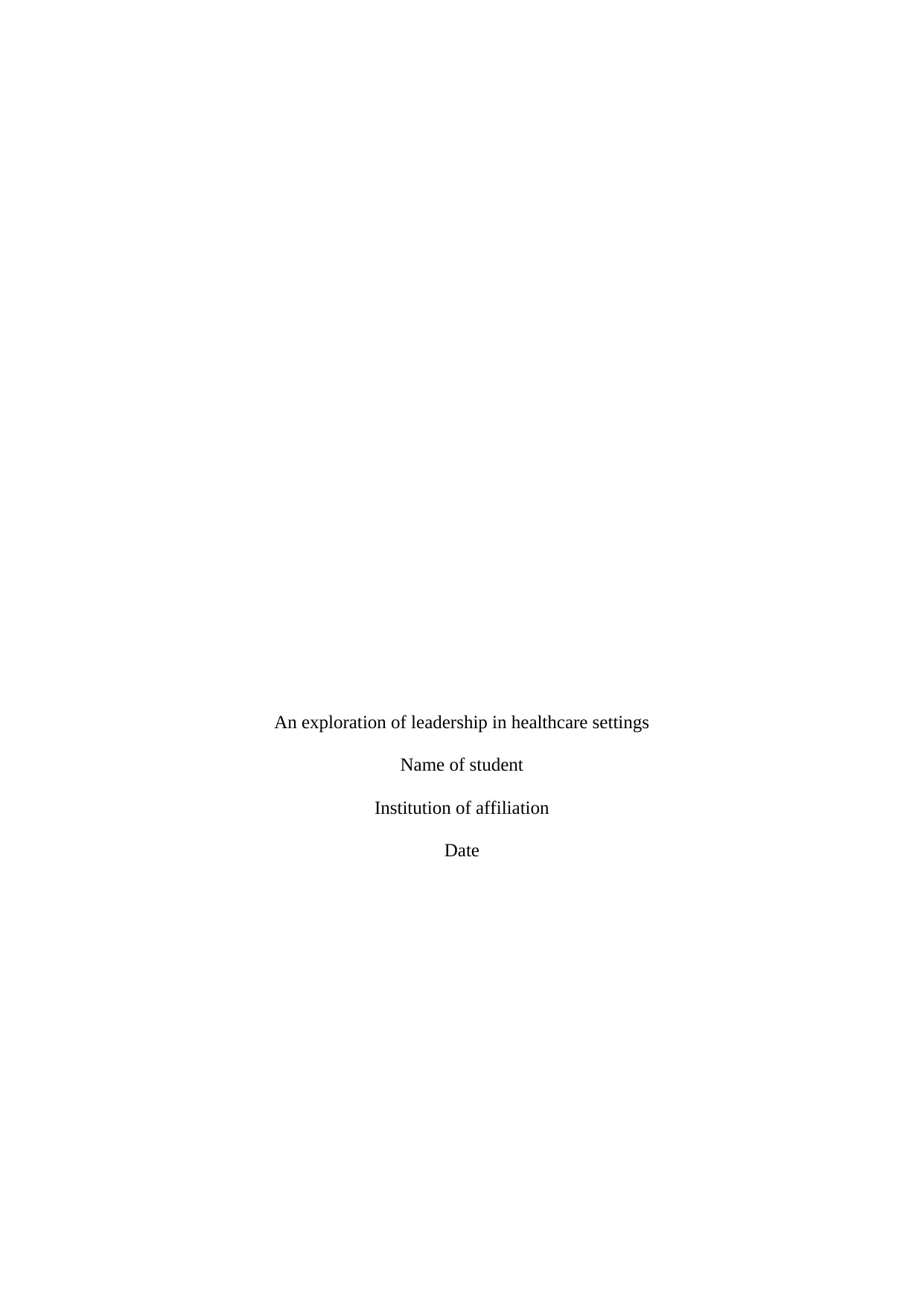
An exploration of leadership in healthcare settings
Name of student
Institution of affiliation
Date
Name of student
Institution of affiliation
Date
Paraphrase This Document
Need a fresh take? Get an instant paraphrase of this document with our AI Paraphraser
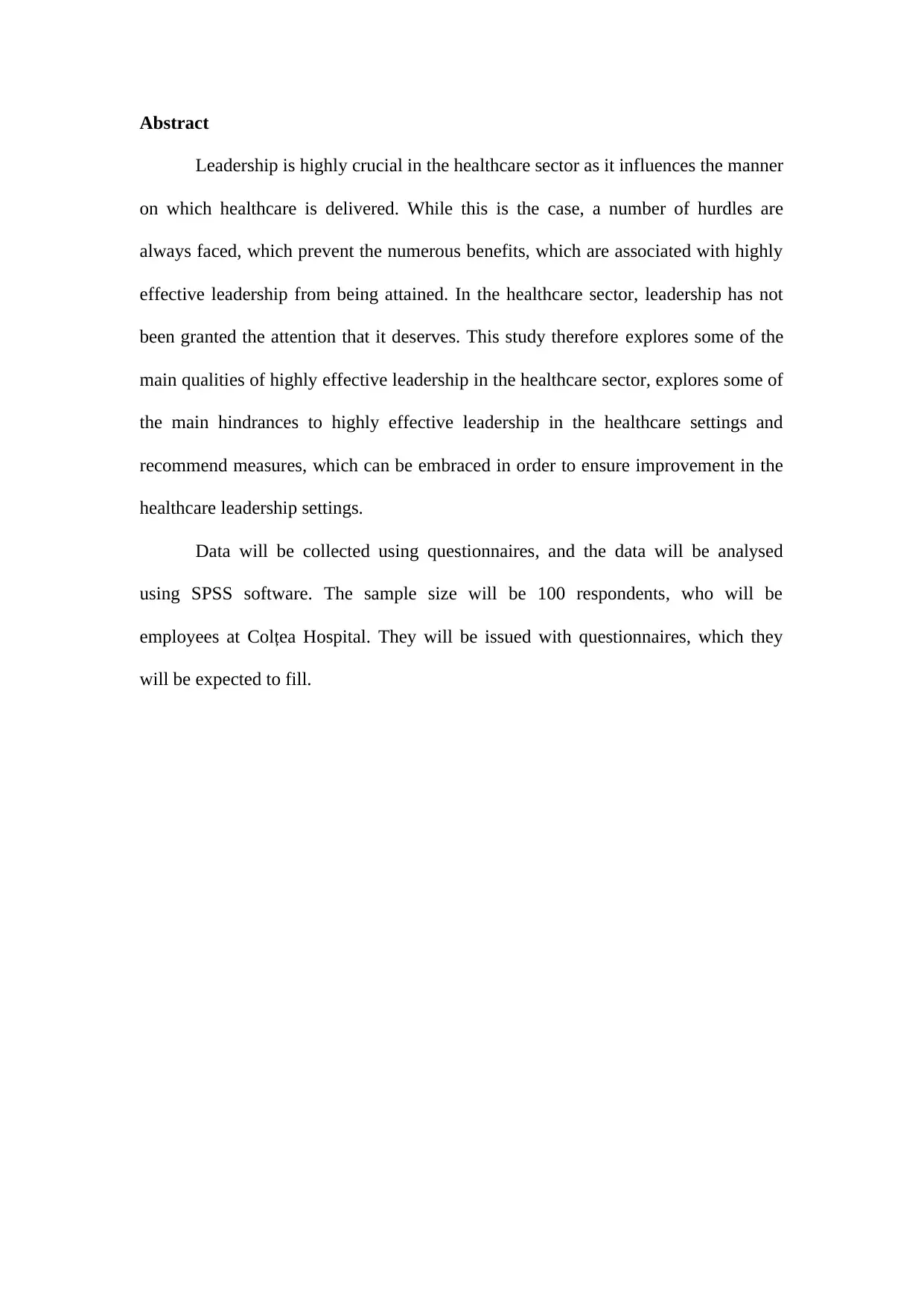
Abstract
Leadership is highly crucial in the healthcare sector as it influences the manner
on which healthcare is delivered. While this is the case, a number of hurdles are
always faced, which prevent the numerous benefits, which are associated with highly
effective leadership from being attained. In the healthcare sector, leadership has not
been granted the attention that it deserves. This study therefore explores some of the
main qualities of highly effective leadership in the healthcare sector, explores some of
the main hindrances to highly effective leadership in the healthcare settings and
recommend measures, which can be embraced in order to ensure improvement in the
healthcare leadership settings.
Data will be collected using questionnaires, and the data will be analysed
using SPSS software. The sample size will be 100 respondents, who will be
employees at Colțea Hospital. They will be issued with questionnaires, which they
will be expected to fill.
Leadership is highly crucial in the healthcare sector as it influences the manner
on which healthcare is delivered. While this is the case, a number of hurdles are
always faced, which prevent the numerous benefits, which are associated with highly
effective leadership from being attained. In the healthcare sector, leadership has not
been granted the attention that it deserves. This study therefore explores some of the
main qualities of highly effective leadership in the healthcare sector, explores some of
the main hindrances to highly effective leadership in the healthcare settings and
recommend measures, which can be embraced in order to ensure improvement in the
healthcare leadership settings.
Data will be collected using questionnaires, and the data will be analysed
using SPSS software. The sample size will be 100 respondents, who will be
employees at Colțea Hospital. They will be issued with questionnaires, which they
will be expected to fill.
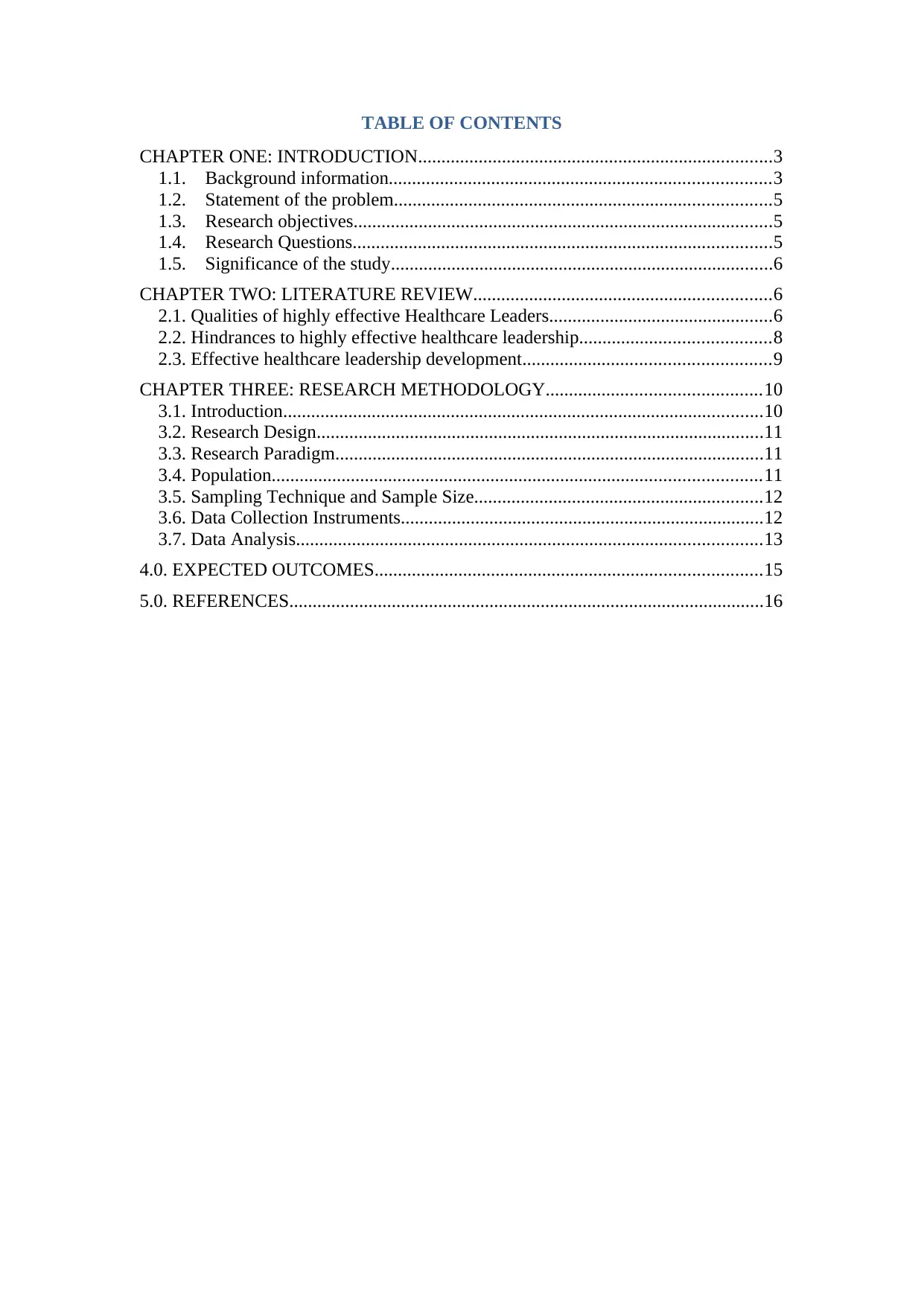
TABLE OF CONTENTS
CHAPTER ONE: INTRODUCTION............................................................................3
1.1. Background information..................................................................................3
1.2. Statement of the problem.................................................................................5
1.3. Research objectives..........................................................................................5
1.4. Research Questions..........................................................................................5
1.5. Significance of the study..................................................................................6
CHAPTER TWO: LITERATURE REVIEW................................................................6
2.1. Qualities of highly effective Healthcare Leaders................................................6
2.2. Hindrances to highly effective healthcare leadership.........................................8
2.3. Effective healthcare leadership development.....................................................9
CHAPTER THREE: RESEARCH METHODOLOGY..............................................10
3.1. Introduction.......................................................................................................10
3.2. Research Design................................................................................................11
3.3. Research Paradigm............................................................................................11
3.4. Population.........................................................................................................11
3.5. Sampling Technique and Sample Size..............................................................12
3.6. Data Collection Instruments..............................................................................12
3.7. Data Analysis....................................................................................................13
4.0. EXPECTED OUTCOMES...................................................................................15
5.0. REFERENCES......................................................................................................16
CHAPTER ONE: INTRODUCTION............................................................................3
1.1. Background information..................................................................................3
1.2. Statement of the problem.................................................................................5
1.3. Research objectives..........................................................................................5
1.4. Research Questions..........................................................................................5
1.5. Significance of the study..................................................................................6
CHAPTER TWO: LITERATURE REVIEW................................................................6
2.1. Qualities of highly effective Healthcare Leaders................................................6
2.2. Hindrances to highly effective healthcare leadership.........................................8
2.3. Effective healthcare leadership development.....................................................9
CHAPTER THREE: RESEARCH METHODOLOGY..............................................10
3.1. Introduction.......................................................................................................10
3.2. Research Design................................................................................................11
3.3. Research Paradigm............................................................................................11
3.4. Population.........................................................................................................11
3.5. Sampling Technique and Sample Size..............................................................12
3.6. Data Collection Instruments..............................................................................12
3.7. Data Analysis....................................................................................................13
4.0. EXPECTED OUTCOMES...................................................................................15
5.0. REFERENCES......................................................................................................16
⊘ This is a preview!⊘
Do you want full access?
Subscribe today to unlock all pages.

Trusted by 1+ million students worldwide
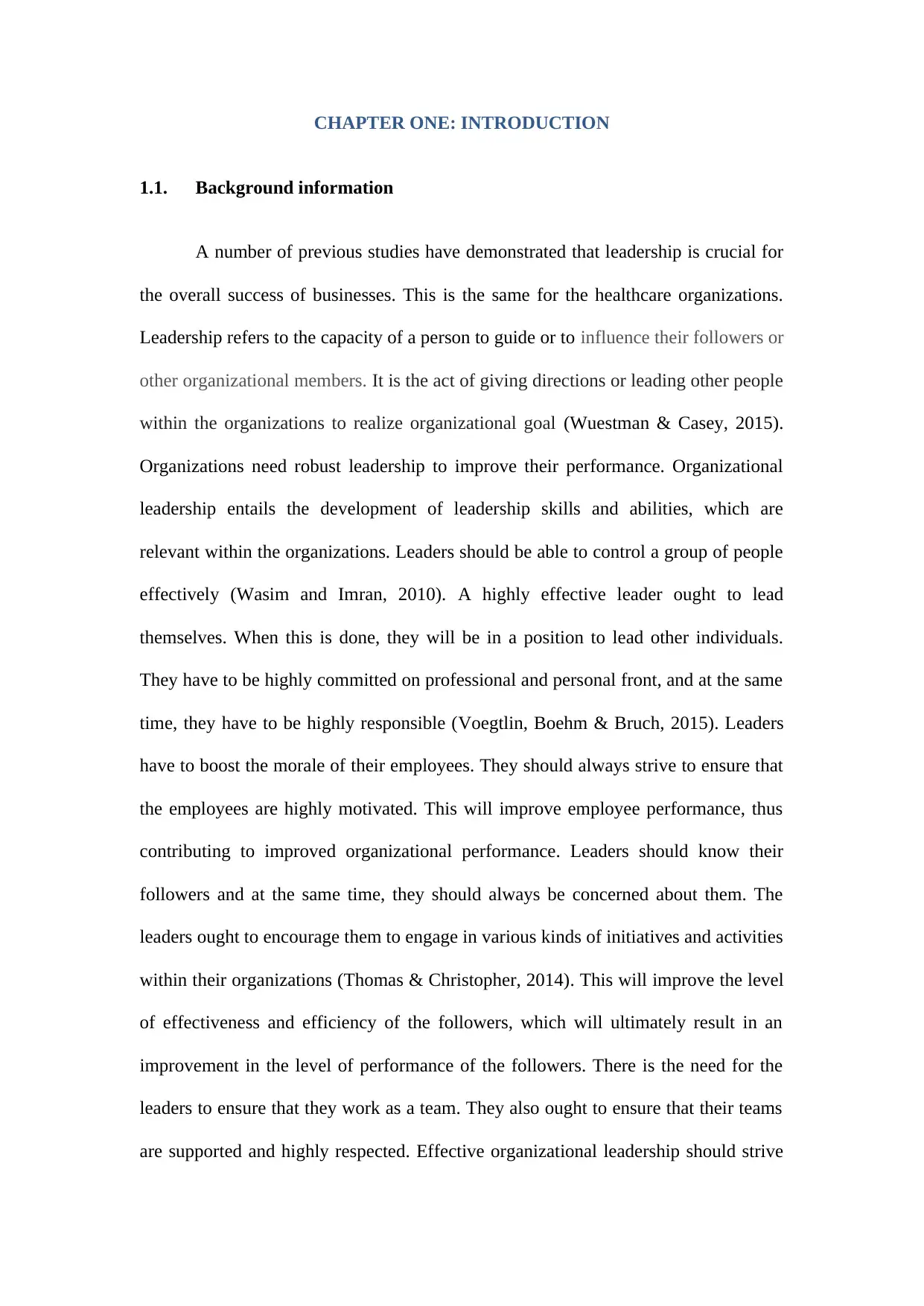
CHAPTER ONE: INTRODUCTION
1.1. Background information
A number of previous studies have demonstrated that leadership is crucial for
the overall success of businesses. This is the same for the healthcare organizations.
Leadership refers to the capacity of a person to guide or to influence their followers or
other organizational members. It is the act of giving directions or leading other people
within the organizations to realize organizational goal (Wuestman & Casey, 2015).
Organizations need robust leadership to improve their performance. Organizational
leadership entails the development of leadership skills and abilities, which are
relevant within the organizations. Leaders should be able to control a group of people
effectively (Wasim and Imran, 2010). A highly effective leader ought to lead
themselves. When this is done, they will be in a position to lead other individuals.
They have to be highly committed on professional and personal front, and at the same
time, they have to be highly responsible (Voegtlin, Boehm & Bruch, 2015). Leaders
have to boost the morale of their employees. They should always strive to ensure that
the employees are highly motivated. This will improve employee performance, thus
contributing to improved organizational performance. Leaders should know their
followers and at the same time, they should always be concerned about them. The
leaders ought to encourage them to engage in various kinds of initiatives and activities
within their organizations (Thomas & Christopher, 2014). This will improve the level
of effectiveness and efficiency of the followers, which will ultimately result in an
improvement in the level of performance of the followers. There is the need for the
leaders to ensure that they work as a team. They also ought to ensure that their teams
are supported and highly respected. Effective organizational leadership should strive
1.1. Background information
A number of previous studies have demonstrated that leadership is crucial for
the overall success of businesses. This is the same for the healthcare organizations.
Leadership refers to the capacity of a person to guide or to influence their followers or
other organizational members. It is the act of giving directions or leading other people
within the organizations to realize organizational goal (Wuestman & Casey, 2015).
Organizations need robust leadership to improve their performance. Organizational
leadership entails the development of leadership skills and abilities, which are
relevant within the organizations. Leaders should be able to control a group of people
effectively (Wasim and Imran, 2010). A highly effective leader ought to lead
themselves. When this is done, they will be in a position to lead other individuals.
They have to be highly committed on professional and personal front, and at the same
time, they have to be highly responsible (Voegtlin, Boehm & Bruch, 2015). Leaders
have to boost the morale of their employees. They should always strive to ensure that
the employees are highly motivated. This will improve employee performance, thus
contributing to improved organizational performance. Leaders should know their
followers and at the same time, they should always be concerned about them. The
leaders ought to encourage them to engage in various kinds of initiatives and activities
within their organizations (Thomas & Christopher, 2014). This will improve the level
of effectiveness and efficiency of the followers, which will ultimately result in an
improvement in the level of performance of the followers. There is the need for the
leaders to ensure that they work as a team. They also ought to ensure that their teams
are supported and highly respected. Effective organizational leadership should strive
Paraphrase This Document
Need a fresh take? Get an instant paraphrase of this document with our AI Paraphraser
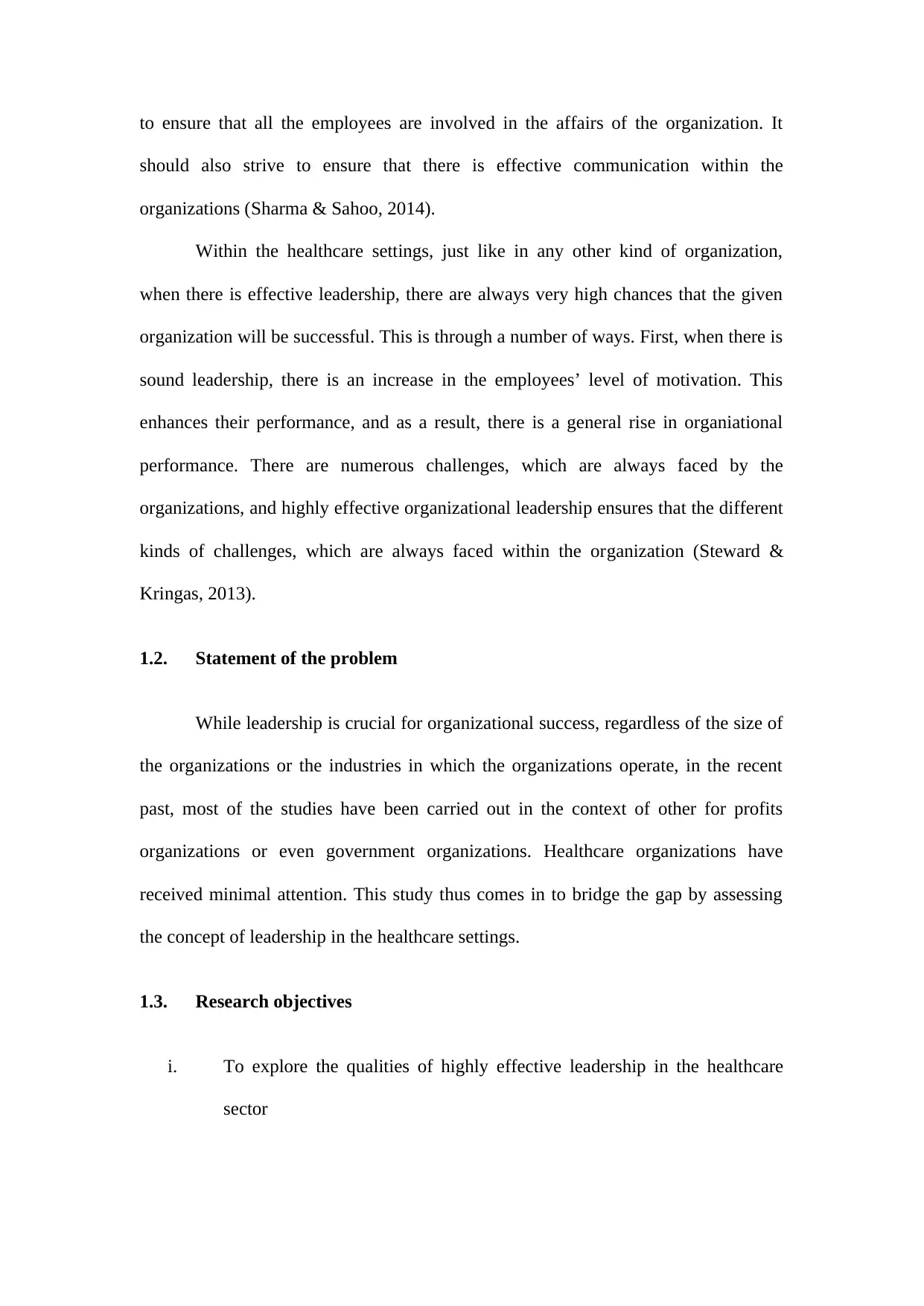
to ensure that all the employees are involved in the affairs of the organization. It
should also strive to ensure that there is effective communication within the
organizations (Sharma & Sahoo, 2014).
Within the healthcare settings, just like in any other kind of organization,
when there is effective leadership, there are always very high chances that the given
organization will be successful. This is through a number of ways. First, when there is
sound leadership, there is an increase in the employees’ level of motivation. This
enhances their performance, and as a result, there is a general rise in organiational
performance. There are numerous challenges, which are always faced by the
organizations, and highly effective organizational leadership ensures that the different
kinds of challenges, which are always faced within the organization (Steward &
Kringas, 2013).
1.2. Statement of the problem
While leadership is crucial for organizational success, regardless of the size of
the organizations or the industries in which the organizations operate, in the recent
past, most of the studies have been carried out in the context of other for profits
organizations or even government organizations. Healthcare organizations have
received minimal attention. This study thus comes in to bridge the gap by assessing
the concept of leadership in the healthcare settings.
1.3. Research objectives
i. To explore the qualities of highly effective leadership in the healthcare
sector
should also strive to ensure that there is effective communication within the
organizations (Sharma & Sahoo, 2014).
Within the healthcare settings, just like in any other kind of organization,
when there is effective leadership, there are always very high chances that the given
organization will be successful. This is through a number of ways. First, when there is
sound leadership, there is an increase in the employees’ level of motivation. This
enhances their performance, and as a result, there is a general rise in organiational
performance. There are numerous challenges, which are always faced by the
organizations, and highly effective organizational leadership ensures that the different
kinds of challenges, which are always faced within the organization (Steward &
Kringas, 2013).
1.2. Statement of the problem
While leadership is crucial for organizational success, regardless of the size of
the organizations or the industries in which the organizations operate, in the recent
past, most of the studies have been carried out in the context of other for profits
organizations or even government organizations. Healthcare organizations have
received minimal attention. This study thus comes in to bridge the gap by assessing
the concept of leadership in the healthcare settings.
1.3. Research objectives
i. To explore the qualities of highly effective leadership in the healthcare
sector
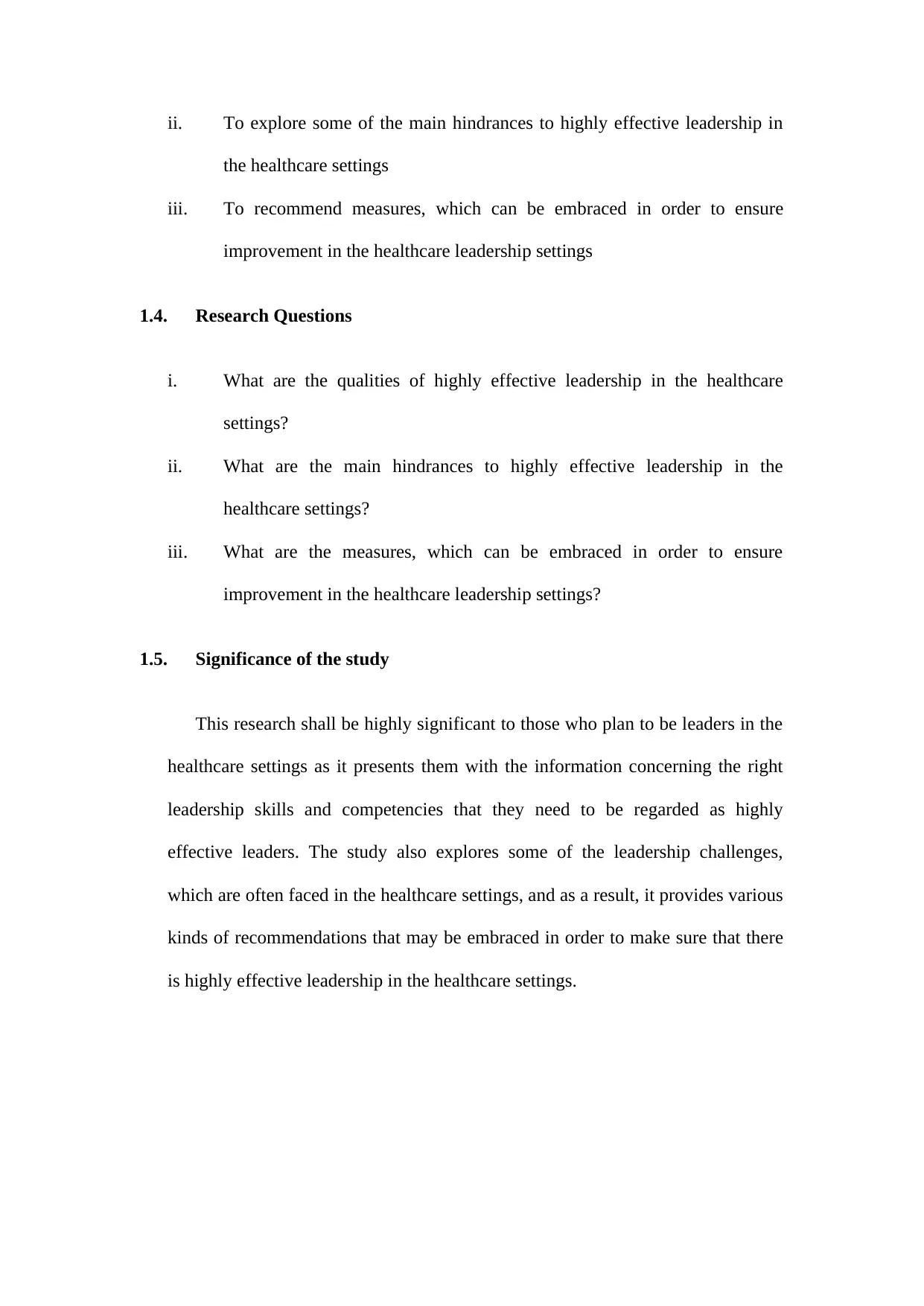
ii. To explore some of the main hindrances to highly effective leadership in
the healthcare settings
iii. To recommend measures, which can be embraced in order to ensure
improvement in the healthcare leadership settings
1.4. Research Questions
i. What are the qualities of highly effective leadership in the healthcare
settings?
ii. What are the main hindrances to highly effective leadership in the
healthcare settings?
iii. What are the measures, which can be embraced in order to ensure
improvement in the healthcare leadership settings?
1.5. Significance of the study
This research shall be highly significant to those who plan to be leaders in the
healthcare settings as it presents them with the information concerning the right
leadership skills and competencies that they need to be regarded as highly
effective leaders. The study also explores some of the leadership challenges,
which are often faced in the healthcare settings, and as a result, it provides various
kinds of recommendations that may be embraced in order to make sure that there
is highly effective leadership in the healthcare settings.
the healthcare settings
iii. To recommend measures, which can be embraced in order to ensure
improvement in the healthcare leadership settings
1.4. Research Questions
i. What are the qualities of highly effective leadership in the healthcare
settings?
ii. What are the main hindrances to highly effective leadership in the
healthcare settings?
iii. What are the measures, which can be embraced in order to ensure
improvement in the healthcare leadership settings?
1.5. Significance of the study
This research shall be highly significant to those who plan to be leaders in the
healthcare settings as it presents them with the information concerning the right
leadership skills and competencies that they need to be regarded as highly
effective leaders. The study also explores some of the leadership challenges,
which are often faced in the healthcare settings, and as a result, it provides various
kinds of recommendations that may be embraced in order to make sure that there
is highly effective leadership in the healthcare settings.
⊘ This is a preview!⊘
Do you want full access?
Subscribe today to unlock all pages.

Trusted by 1+ million students worldwide
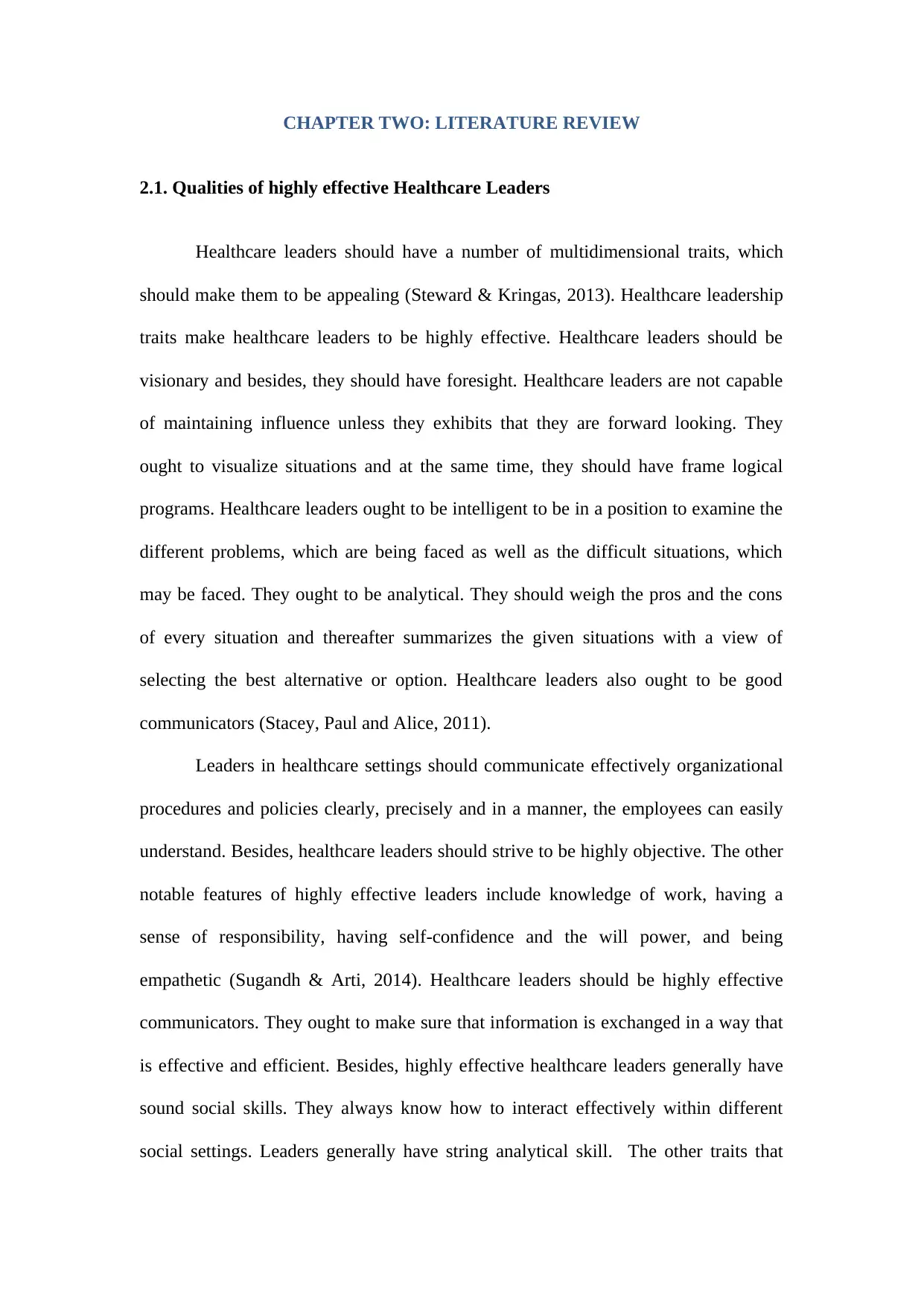
CHAPTER TWO: LITERATURE REVIEW
2.1. Qualities of highly effective Healthcare Leaders
Healthcare leaders should have a number of multidimensional traits, which
should make them to be appealing (Steward & Kringas, 2013). Healthcare leadership
traits make healthcare leaders to be highly effective. Healthcare leaders should be
visionary and besides, they should have foresight. Healthcare leaders are not capable
of maintaining influence unless they exhibits that they are forward looking. They
ought to visualize situations and at the same time, they should have frame logical
programs. Healthcare leaders ought to be intelligent to be in a position to examine the
different problems, which are being faced as well as the difficult situations, which
may be faced. They ought to be analytical. They should weigh the pros and the cons
of every situation and thereafter summarizes the given situations with a view of
selecting the best alternative or option. Healthcare leaders also ought to be good
communicators (Stacey, Paul and Alice, 2011).
Leaders in healthcare settings should communicate effectively organizational
procedures and policies clearly, precisely and in a manner, the employees can easily
understand. Besides, healthcare leaders should strive to be highly objective. The other
notable features of highly effective leaders include knowledge of work, having a
sense of responsibility, having self-confidence and the will power, and being
empathetic (Sugandh & Arti, 2014). Healthcare leaders should be highly effective
communicators. They ought to make sure that information is exchanged in a way that
is effective and efficient. Besides, highly effective healthcare leaders generally have
sound social skills. They always know how to interact effectively within different
social settings. Leaders generally have string analytical skill. The other traits that
2.1. Qualities of highly effective Healthcare Leaders
Healthcare leaders should have a number of multidimensional traits, which
should make them to be appealing (Steward & Kringas, 2013). Healthcare leadership
traits make healthcare leaders to be highly effective. Healthcare leaders should be
visionary and besides, they should have foresight. Healthcare leaders are not capable
of maintaining influence unless they exhibits that they are forward looking. They
ought to visualize situations and at the same time, they should have frame logical
programs. Healthcare leaders ought to be intelligent to be in a position to examine the
different problems, which are being faced as well as the difficult situations, which
may be faced. They ought to be analytical. They should weigh the pros and the cons
of every situation and thereafter summarizes the given situations with a view of
selecting the best alternative or option. Healthcare leaders also ought to be good
communicators (Stacey, Paul and Alice, 2011).
Leaders in healthcare settings should communicate effectively organizational
procedures and policies clearly, precisely and in a manner, the employees can easily
understand. Besides, healthcare leaders should strive to be highly objective. The other
notable features of highly effective leaders include knowledge of work, having a
sense of responsibility, having self-confidence and the will power, and being
empathetic (Sugandh & Arti, 2014). Healthcare leaders should be highly effective
communicators. They ought to make sure that information is exchanged in a way that
is effective and efficient. Besides, highly effective healthcare leaders generally have
sound social skills. They always know how to interact effectively within different
social settings. Leaders generally have string analytical skill. The other traits that
Paraphrase This Document
Need a fresh take? Get an instant paraphrase of this document with our AI Paraphraser
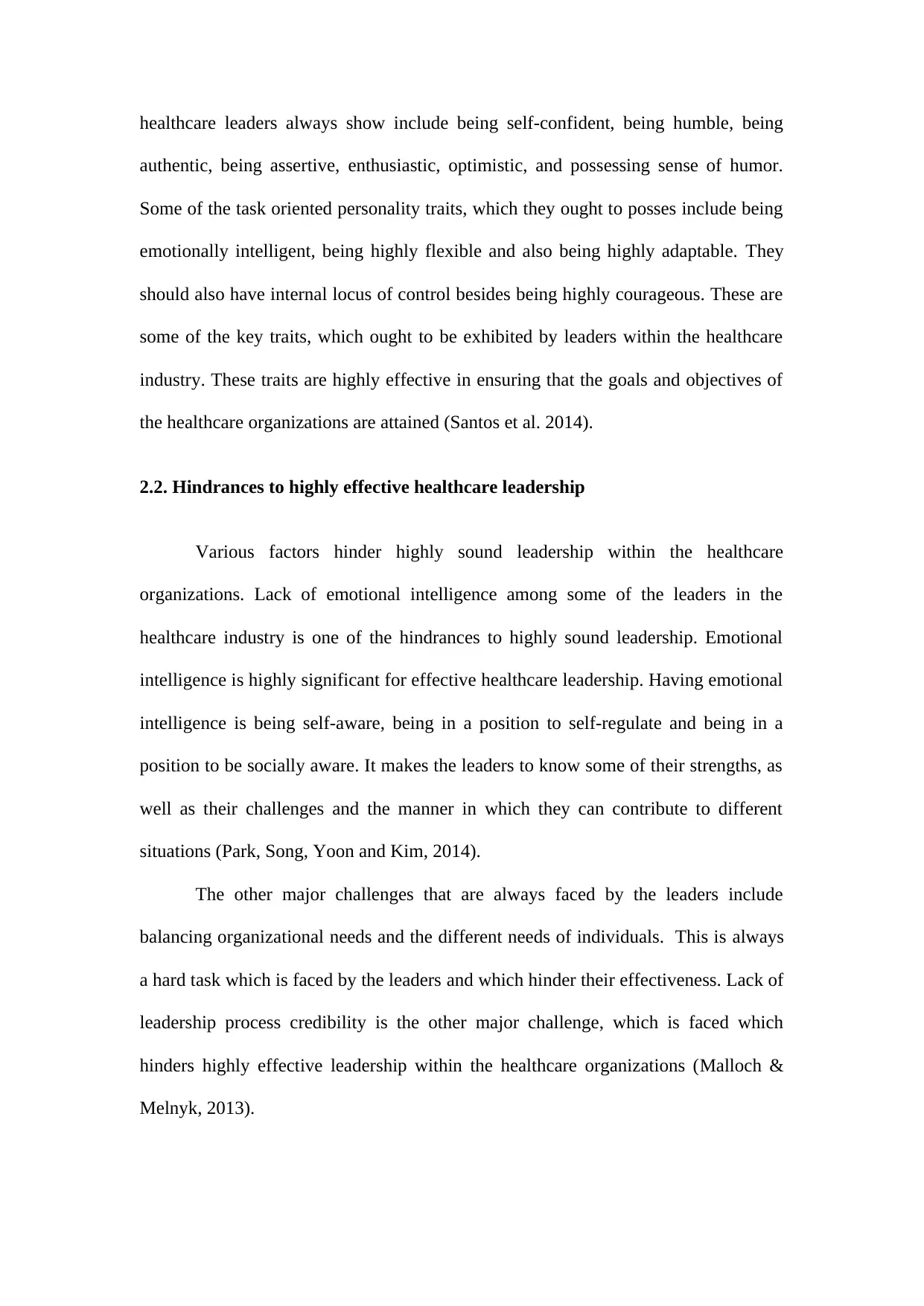
healthcare leaders always show include being self-confident, being humble, being
authentic, being assertive, enthusiastic, optimistic, and possessing sense of humor.
Some of the task oriented personality traits, which they ought to posses include being
emotionally intelligent, being highly flexible and also being highly adaptable. They
should also have internal locus of control besides being highly courageous. These are
some of the key traits, which ought to be exhibited by leaders within the healthcare
industry. These traits are highly effective in ensuring that the goals and objectives of
the healthcare organizations are attained (Santos et al. 2014).
2.2. Hindrances to highly effective healthcare leadership
Various factors hinder highly sound leadership within the healthcare
organizations. Lack of emotional intelligence among some of the leaders in the
healthcare industry is one of the hindrances to highly sound leadership. Emotional
intelligence is highly significant for effective healthcare leadership. Having emotional
intelligence is being self-aware, being in a position to self-regulate and being in a
position to be socially aware. It makes the leaders to know some of their strengths, as
well as their challenges and the manner in which they can contribute to different
situations (Park, Song, Yoon and Kim, 2014).
The other major challenges that are always faced by the leaders include
balancing organizational needs and the different needs of individuals. This is always
a hard task which is faced by the leaders and which hinder their effectiveness. Lack of
leadership process credibility is the other major challenge, which is faced which
hinders highly effective leadership within the healthcare organizations (Malloch &
Melnyk, 2013).
authentic, being assertive, enthusiastic, optimistic, and possessing sense of humor.
Some of the task oriented personality traits, which they ought to posses include being
emotionally intelligent, being highly flexible and also being highly adaptable. They
should also have internal locus of control besides being highly courageous. These are
some of the key traits, which ought to be exhibited by leaders within the healthcare
industry. These traits are highly effective in ensuring that the goals and objectives of
the healthcare organizations are attained (Santos et al. 2014).
2.2. Hindrances to highly effective healthcare leadership
Various factors hinder highly sound leadership within the healthcare
organizations. Lack of emotional intelligence among some of the leaders in the
healthcare industry is one of the hindrances to highly sound leadership. Emotional
intelligence is highly significant for effective healthcare leadership. Having emotional
intelligence is being self-aware, being in a position to self-regulate and being in a
position to be socially aware. It makes the leaders to know some of their strengths, as
well as their challenges and the manner in which they can contribute to different
situations (Park, Song, Yoon and Kim, 2014).
The other major challenges that are always faced by the leaders include
balancing organizational needs and the different needs of individuals. This is always
a hard task which is faced by the leaders and which hinder their effectiveness. Lack of
leadership process credibility is the other major challenge, which is faced which
hinders highly effective leadership within the healthcare organizations (Malloch &
Melnyk, 2013).
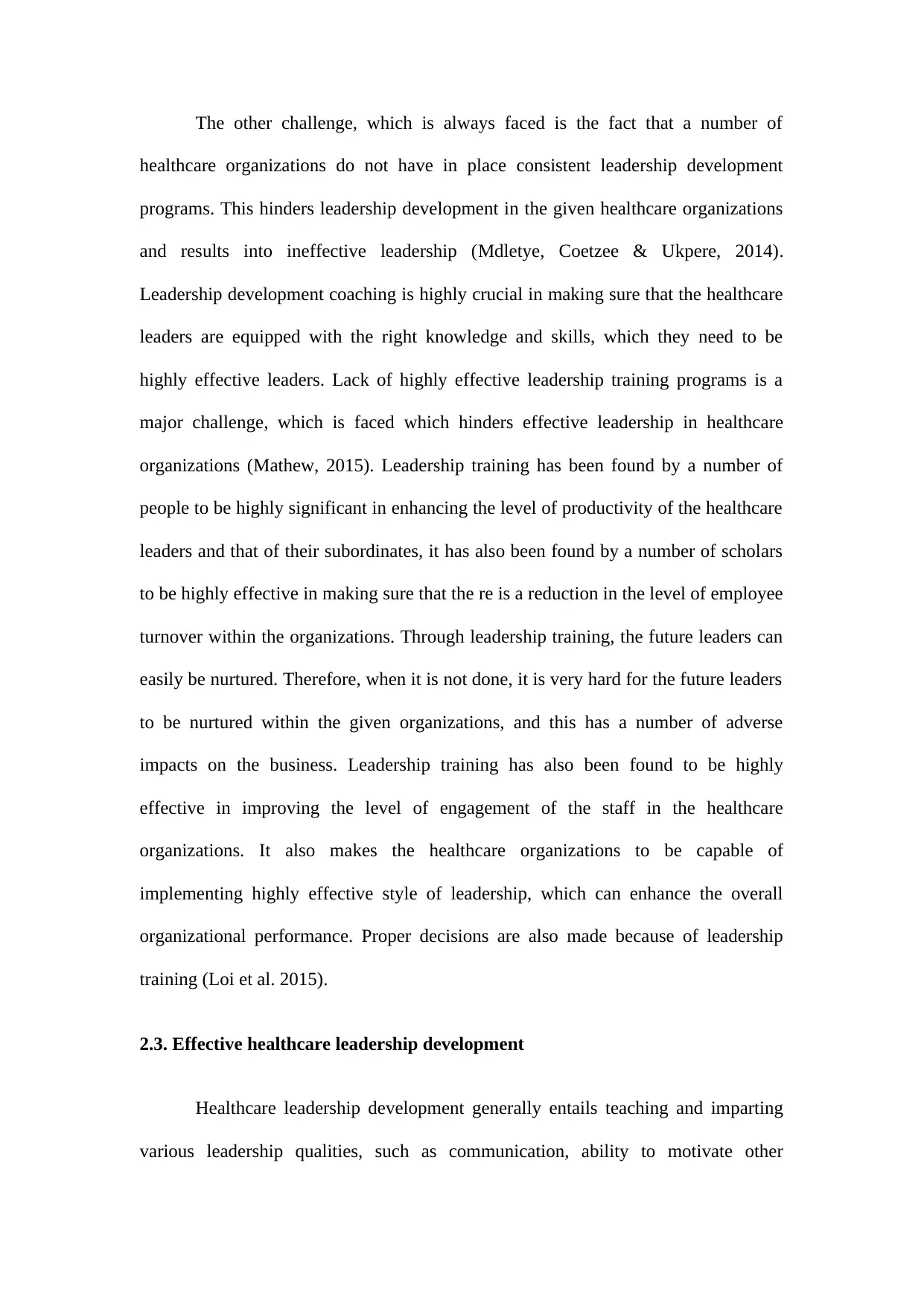
The other challenge, which is always faced is the fact that a number of
healthcare organizations do not have in place consistent leadership development
programs. This hinders leadership development in the given healthcare organizations
and results into ineffective leadership (Mdletye, Coetzee & Ukpere, 2014).
Leadership development coaching is highly crucial in making sure that the healthcare
leaders are equipped with the right knowledge and skills, which they need to be
highly effective leaders. Lack of highly effective leadership training programs is a
major challenge, which is faced which hinders effective leadership in healthcare
organizations (Mathew, 2015). Leadership training has been found by a number of
people to be highly significant in enhancing the level of productivity of the healthcare
leaders and that of their subordinates, it has also been found by a number of scholars
to be highly effective in making sure that the re is a reduction in the level of employee
turnover within the organizations. Through leadership training, the future leaders can
easily be nurtured. Therefore, when it is not done, it is very hard for the future leaders
to be nurtured within the given organizations, and this has a number of adverse
impacts on the business. Leadership training has also been found to be highly
effective in improving the level of engagement of the staff in the healthcare
organizations. It also makes the healthcare organizations to be capable of
implementing highly effective style of leadership, which can enhance the overall
organizational performance. Proper decisions are also made because of leadership
training (Loi et al. 2015).
2.3. Effective healthcare leadership development
Healthcare leadership development generally entails teaching and imparting
various leadership qualities, such as communication, ability to motivate other
healthcare organizations do not have in place consistent leadership development
programs. This hinders leadership development in the given healthcare organizations
and results into ineffective leadership (Mdletye, Coetzee & Ukpere, 2014).
Leadership development coaching is highly crucial in making sure that the healthcare
leaders are equipped with the right knowledge and skills, which they need to be
highly effective leaders. Lack of highly effective leadership training programs is a
major challenge, which is faced which hinders effective leadership in healthcare
organizations (Mathew, 2015). Leadership training has been found by a number of
people to be highly significant in enhancing the level of productivity of the healthcare
leaders and that of their subordinates, it has also been found by a number of scholars
to be highly effective in making sure that the re is a reduction in the level of employee
turnover within the organizations. Through leadership training, the future leaders can
easily be nurtured. Therefore, when it is not done, it is very hard for the future leaders
to be nurtured within the given organizations, and this has a number of adverse
impacts on the business. Leadership training has also been found to be highly
effective in improving the level of engagement of the staff in the healthcare
organizations. It also makes the healthcare organizations to be capable of
implementing highly effective style of leadership, which can enhance the overall
organizational performance. Proper decisions are also made because of leadership
training (Loi et al. 2015).
2.3. Effective healthcare leadership development
Healthcare leadership development generally entails teaching and imparting
various leadership qualities, such as communication, ability to motivate other
⊘ This is a preview!⊘
Do you want full access?
Subscribe today to unlock all pages.

Trusted by 1+ million students worldwide
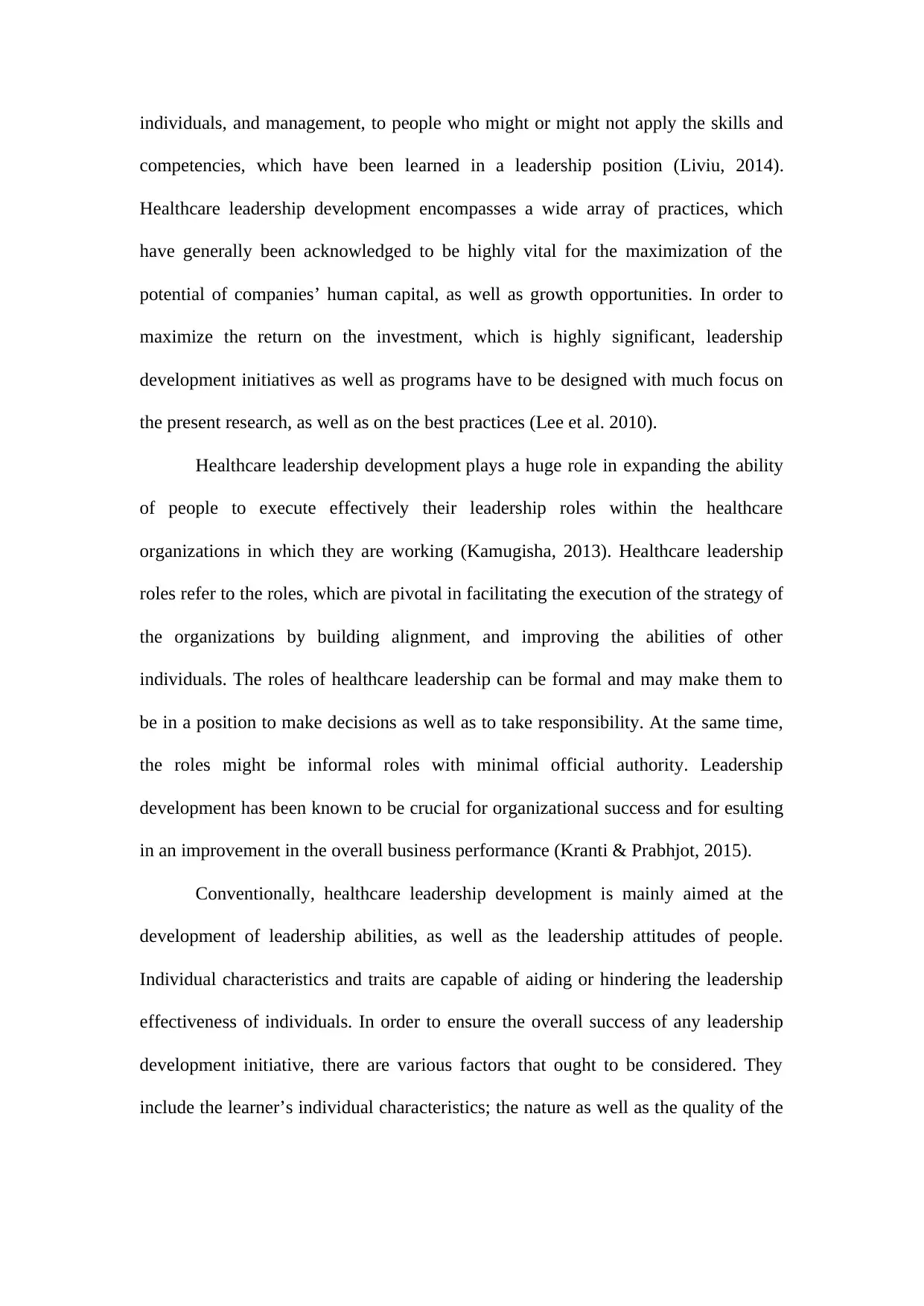
individuals, and management, to people who might or might not apply the skills and
competencies, which have been learned in a leadership position (Liviu, 2014).
Healthcare leadership development encompasses a wide array of practices, which
have generally been acknowledged to be highly vital for the maximization of the
potential of companies’ human capital, as well as growth opportunities. In order to
maximize the return on the investment, which is highly significant, leadership
development initiatives as well as programs have to be designed with much focus on
the present research, as well as on the best practices (Lee et al. 2010).
Healthcare leadership development plays a huge role in expanding the ability
of people to execute effectively their leadership roles within the healthcare
organizations in which they are working (Kamugisha, 2013). Healthcare leadership
roles refer to the roles, which are pivotal in facilitating the execution of the strategy of
the organizations by building alignment, and improving the abilities of other
individuals. The roles of healthcare leadership can be formal and may make them to
be in a position to make decisions as well as to take responsibility. At the same time,
the roles might be informal roles with minimal official authority. Leadership
development has been known to be crucial for organizational success and for esulting
in an improvement in the overall business performance (Kranti & Prabhjot, 2015).
Conventionally, healthcare leadership development is mainly aimed at the
development of leadership abilities, as well as the leadership attitudes of people.
Individual characteristics and traits are capable of aiding or hindering the leadership
effectiveness of individuals. In order to ensure the overall success of any leadership
development initiative, there are various factors that ought to be considered. They
include the learner’s individual characteristics; the nature as well as the quality of the
competencies, which have been learned in a leadership position (Liviu, 2014).
Healthcare leadership development encompasses a wide array of practices, which
have generally been acknowledged to be highly vital for the maximization of the
potential of companies’ human capital, as well as growth opportunities. In order to
maximize the return on the investment, which is highly significant, leadership
development initiatives as well as programs have to be designed with much focus on
the present research, as well as on the best practices (Lee et al. 2010).
Healthcare leadership development plays a huge role in expanding the ability
of people to execute effectively their leadership roles within the healthcare
organizations in which they are working (Kamugisha, 2013). Healthcare leadership
roles refer to the roles, which are pivotal in facilitating the execution of the strategy of
the organizations by building alignment, and improving the abilities of other
individuals. The roles of healthcare leadership can be formal and may make them to
be in a position to make decisions as well as to take responsibility. At the same time,
the roles might be informal roles with minimal official authority. Leadership
development has been known to be crucial for organizational success and for esulting
in an improvement in the overall business performance (Kranti & Prabhjot, 2015).
Conventionally, healthcare leadership development is mainly aimed at the
development of leadership abilities, as well as the leadership attitudes of people.
Individual characteristics and traits are capable of aiding or hindering the leadership
effectiveness of individuals. In order to ensure the overall success of any leadership
development initiative, there are various factors that ought to be considered. They
include the learner’s individual characteristics; the nature as well as the quality of the
Paraphrase This Document
Need a fresh take? Get an instant paraphrase of this document with our AI Paraphraser
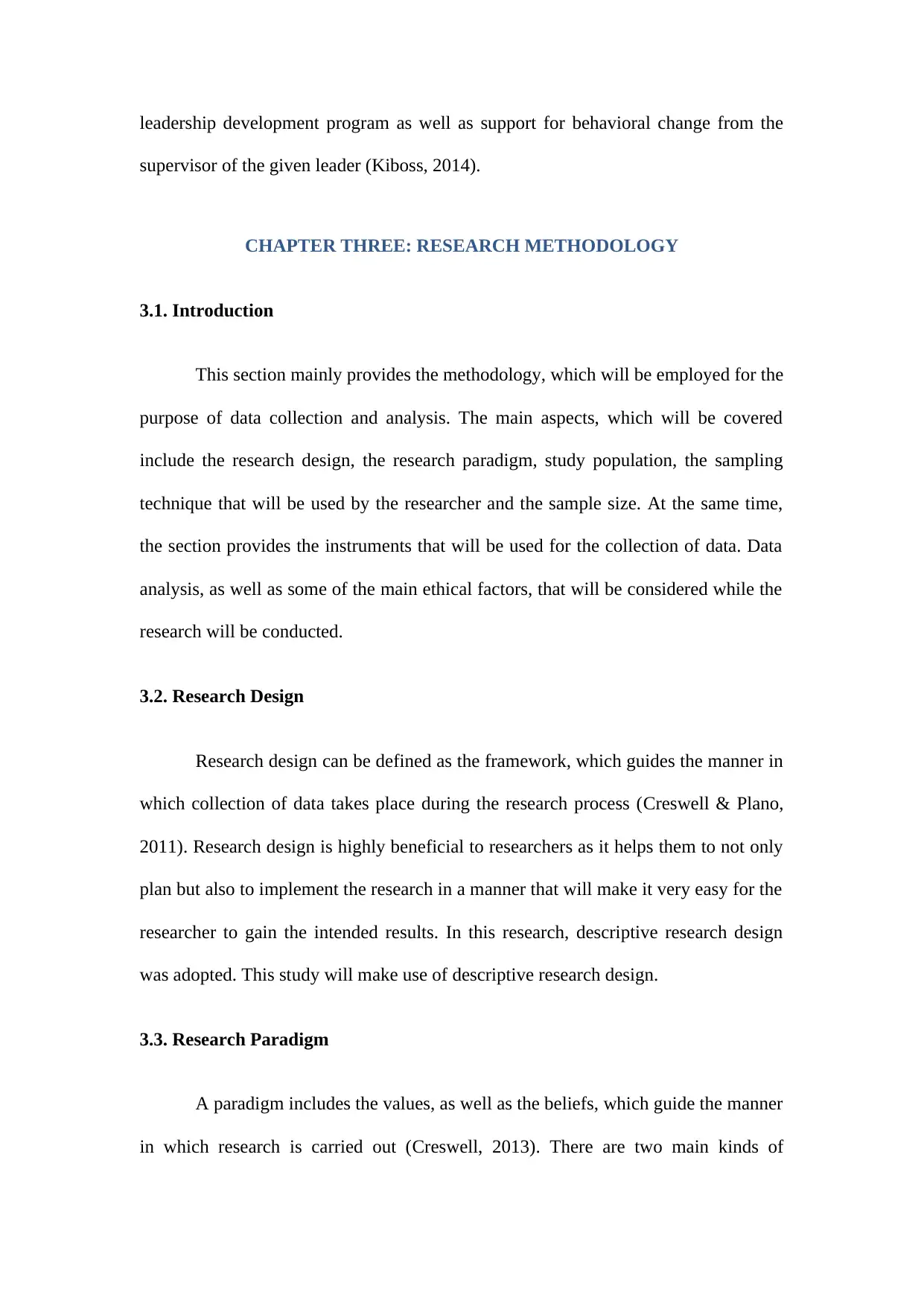
leadership development program as well as support for behavioral change from the
supervisor of the given leader (Kiboss, 2014).
CHAPTER THREE: RESEARCH METHODOLOGY
3.1. Introduction
This section mainly provides the methodology, which will be employed for the
purpose of data collection and analysis. The main aspects, which will be covered
include the research design, the research paradigm, study population, the sampling
technique that will be used by the researcher and the sample size. At the same time,
the section provides the instruments that will be used for the collection of data. Data
analysis, as well as some of the main ethical factors, that will be considered while the
research will be conducted.
3.2. Research Design
Research design can be defined as the framework, which guides the manner in
which collection of data takes place during the research process (Creswell & Plano,
2011). Research design is highly beneficial to researchers as it helps them to not only
plan but also to implement the research in a manner that will make it very easy for the
researcher to gain the intended results. In this research, descriptive research design
was adopted. This study will make use of descriptive research design.
3.3. Research Paradigm
A paradigm includes the values, as well as the beliefs, which guide the manner
in which research is carried out (Creswell, 2013). There are two main kinds of
supervisor of the given leader (Kiboss, 2014).
CHAPTER THREE: RESEARCH METHODOLOGY
3.1. Introduction
This section mainly provides the methodology, which will be employed for the
purpose of data collection and analysis. The main aspects, which will be covered
include the research design, the research paradigm, study population, the sampling
technique that will be used by the researcher and the sample size. At the same time,
the section provides the instruments that will be used for the collection of data. Data
analysis, as well as some of the main ethical factors, that will be considered while the
research will be conducted.
3.2. Research Design
Research design can be defined as the framework, which guides the manner in
which collection of data takes place during the research process (Creswell & Plano,
2011). Research design is highly beneficial to researchers as it helps them to not only
plan but also to implement the research in a manner that will make it very easy for the
researcher to gain the intended results. In this research, descriptive research design
was adopted. This study will make use of descriptive research design.
3.3. Research Paradigm
A paradigm includes the values, as well as the beliefs, which guide the manner
in which research is carried out (Creswell, 2013). There are two main kinds of
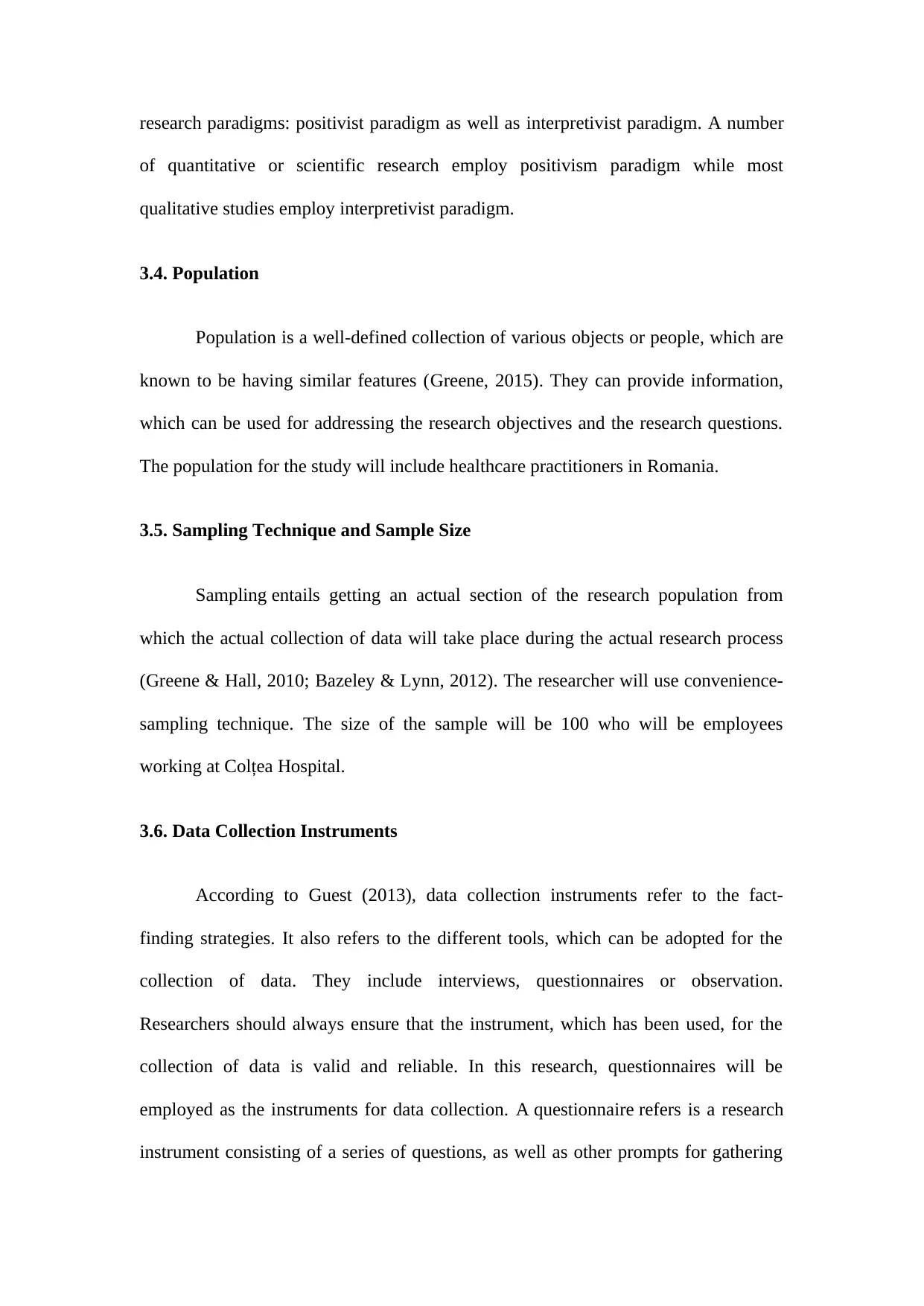
research paradigms: positivist paradigm as well as interpretivist paradigm. A number
of quantitative or scientific research employ positivism paradigm while most
qualitative studies employ interpretivist paradigm.
3.4. Population
Population is a well-defined collection of various objects or people, which are
known to be having similar features (Greene, 2015). They can provide information,
which can be used for addressing the research objectives and the research questions.
The population for the study will include healthcare practitioners in Romania.
3.5. Sampling Technique and Sample Size
Sampling entails getting an actual section of the research population from
which the actual collection of data will take place during the actual research process
(Greene & Hall, 2010; Bazeley & Lynn, 2012). The researcher will use convenience-
sampling technique. The size of the sample will be 100 who will be employees
working at Colțea Hospital.
3.6. Data Collection Instruments
According to Guest (2013), data collection instruments refer to the fact-
finding strategies. It also refers to the different tools, which can be adopted for the
collection of data. They include interviews, questionnaires or observation.
Researchers should always ensure that the instrument, which has been used, for the
collection of data is valid and reliable. In this research, questionnaires will be
employed as the instruments for data collection. A questionnaire refers is a research
instrument consisting of a series of questions, as well as other prompts for gathering
of quantitative or scientific research employ positivism paradigm while most
qualitative studies employ interpretivist paradigm.
3.4. Population
Population is a well-defined collection of various objects or people, which are
known to be having similar features (Greene, 2015). They can provide information,
which can be used for addressing the research objectives and the research questions.
The population for the study will include healthcare practitioners in Romania.
3.5. Sampling Technique and Sample Size
Sampling entails getting an actual section of the research population from
which the actual collection of data will take place during the actual research process
(Greene & Hall, 2010; Bazeley & Lynn, 2012). The researcher will use convenience-
sampling technique. The size of the sample will be 100 who will be employees
working at Colțea Hospital.
3.6. Data Collection Instruments
According to Guest (2013), data collection instruments refer to the fact-
finding strategies. It also refers to the different tools, which can be adopted for the
collection of data. They include interviews, questionnaires or observation.
Researchers should always ensure that the instrument, which has been used, for the
collection of data is valid and reliable. In this research, questionnaires will be
employed as the instruments for data collection. A questionnaire refers is a research
instrument consisting of a series of questions, as well as other prompts for gathering
⊘ This is a preview!⊘
Do you want full access?
Subscribe today to unlock all pages.

Trusted by 1+ million students worldwide
1 out of 19
Related Documents
Your All-in-One AI-Powered Toolkit for Academic Success.
+13062052269
info@desklib.com
Available 24*7 on WhatsApp / Email
![[object Object]](/_next/static/media/star-bottom.7253800d.svg)
Unlock your academic potential
Copyright © 2020–2025 A2Z Services. All Rights Reserved. Developed and managed by ZUCOL.





